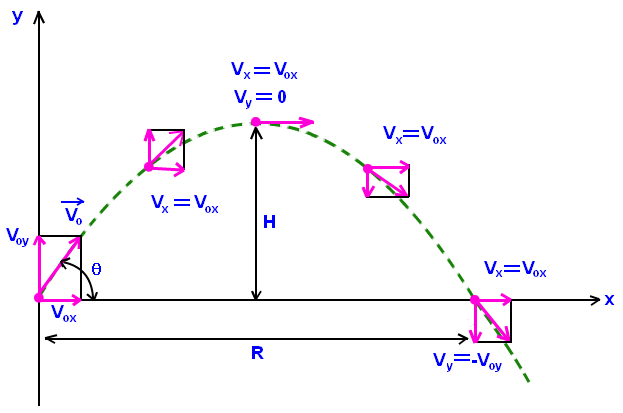Formula
Maximum Height of a Projectile
In vertically upward projection case
Therefore maximum height for an object projected vertically upwards is
Example: A particle is thrown vertically upwards with speed of 10 m/s. Find the maximum height reached by it. Also, find the time to reach maximum height.
Solution:
Time taken in reaching height:
or
Therefore maximum height for an object projected vertically upwards is
Example: A particle is thrown vertically upwards with speed of 10 m/s. Find the maximum height reached by it. Also, find the time to reach maximum height.
Solution:
Time taken in reaching height:
or
Example
Equations of Motion under free fall
In free fall initial velocity of the particle is zero.
Therefore, equations of motion are:
and
Therefore, equations of motion are:
and
Example
Problem on two dimensional motion
Problem:
A particle starts from rest with initial velocity , and acceleration , find net displacement of particle after 4 sec.
Solution:
Given data -
Initial velocity =
Acceleration =
time = 4 sec
Hence
Displacement of particle becomes
m
A particle starts from rest with initial velocity , and acceleration , find net displacement of particle after 4 sec.
Solution:
Given data -
Initial velocity =
Acceleration =
time = 4 sec
Hence
Displacement of particle becomes
m
Example
Problems on freely falling objects
Example: A stone projected vertically up from the top of a cliff reaches the foot of the cliff in . If it is projected vertically downwards with the same speed, it reaches the foot of the cliff in . Then what is its time of free fall from the cliff?
Solution:A to B (with )
8
A to B (with downwards)
free fall,
So, (from 2)
hence,
Solution:A to B (with )
8
A to B (with downwards)
free fall,
So, (from 2)
hence,
Definition
Problems on motion under gravity including collisions with the ground
In free fall initial velocity of the particle is zero.
Therefore,
If a particle is falling from 19.6m then after how long the particle will collide the ground:
Therefore,
If a particle is falling from 19.6m then after how long the particle will collide the ground:
Definition
Projectile Motion

An object that is in flight after being thrown or projected is called a projectile and it's motion is called projectile motion. The motion of a projectile may be thought of as the result of two separate, simultaneously occurring components of motions. One component is along a horizontal direction without any accelaration and the other along the vertical direction with constant accelaration due to the force of gravity.
Parameters of projectile motion:
1. Horizontal Range of the projectile.
2. Maximum height of the projectile.
3. Time of flight of the projectile.
Parameters of projectile motion:
1. Horizontal Range of the projectile.
2. Maximum height of the projectile.
3. Time of flight of the projectile.
Example
Understanding displacement,velocity and acceleration vectors in projectile motion

For a projectile motion displacement can be calculated from the point of projection along the direction of projection. Velocity has two components in horizontal and in vertical direction ,in which horizontal component of velocity remains constant because of absence of force. Acceleration due to gravity is present throughout the motion in vertical direction.
Formula
Derive formula for various parameters for projectile from certain height above the ground

Projectile is projected from height h at an angle of with velocity v.
The basic equations of kinematics at the landing point after flight time T are
..........(1)
vertically and
..........(2)
horizontally. Substitute Eq. (2) for T into (1) and convert from rectangular to polar components to get
............(3)
Maximize R by differentiating this expression with respect to and putting to obtain an expression for the optimum launch angle,
= ..........(4)
This implies and
Substitute these equations in to eq. (3) to get max range,
..........(5)
Formula
projectile motion
Projectile motion with initial horizontal velocity:
When an object is thrown in the horizontal direction from a height, there is no force acting on a particle in horizontal, hence it is having constant velocity along the horizontal.
A gravitational force is acting downwards on the particle, hence it is accelerating downwards.
Hence, as a result path of projectile motion is parabolic.
When an object is thrown in the horizontal direction from a height, there is no force acting on a particle in horizontal, hence it is having constant velocity along the horizontal.
A gravitational force is acting downwards on the particle, hence it is accelerating downwards.
Hence, as a result path of projectile motion is parabolic.
Formula
Range of a Projectile Motion

The horizontal distance travelled by a projectile from its initial position to the position where it passes during its fall is called the horizontal range, . It is the distance travelled during the time of flight . therefore, the range is
......(1)
Or, ......(2)
Equation 2 shows that for a given projectile velocity , is maximum when is maximum, i.e. when .
The maximum horizontal range is, therefore
......(1)
Or, ......(2)
Equation 2 shows that for a given projectile velocity , is maximum when is maximum, i.e. when .
The maximum horizontal range is, therefore
| BookMarks |
Page 11 Page 12 Page 13 Page 14
0 Comments
Post a Comment